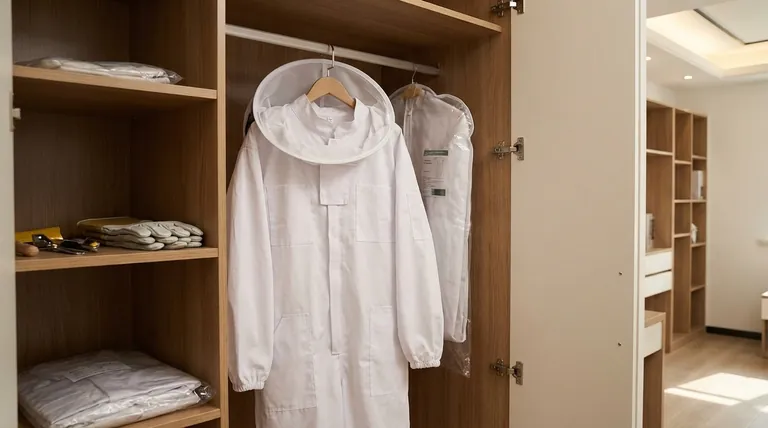To properly hang your beekeeping suit, you should always use a sturdy hanger that supports the suit by the shoulders. Avoid hanging it by the hood, neck, or collar, as this concentrates the suit's weight on delicate areas like the veil and zipper, leading to stretching, distortion, and premature damage.
Proper storage is about more than just maintaining shape; it's a critical practice for preserving the suit's protective integrity. The goal is to keep the material strong, clean, and free from contaminants that could compromise your safety during a hive inspection.

The Principles of Proper Suit Care
A beekeeping suit is a crucial piece of personal protective equipment. How you store it between uses directly impacts its lifespan and, more importantly, its effectiveness in preventing stings.
Why Shoulder Hanging is Non-Negotiable
Hanging your suit on a wide hanger by the shoulders distributes its weight evenly, just as when you are wearing it. This prevents unnatural stress on the seams.
Hanging it by the hood or collar puts all the strain on the zipper and the delicate mesh of the veil. Over time, this will stretch the veil, potentially damage the zipper teeth, and warp the hood's structure, compromising both visibility and protection.
The Critical Role of a Clean Suit
Bees can be attracted to the alarm pheromones released from old stingers left in the fabric. A suit that hasn't been cleaned can provoke more defensive behavior from a colony on your next visit.
Always ensure your suit is clean before storing it for any length of time. This removes any lingering pheromones, honey, or propolis that could attract bees or pests.
Choosing the Right Storage Environment
The ideal storage location is a cool, dry place away from direct sunlight. A closet is often a perfect choice.
Sunlight contains UV rays that degrade and weaken fabric fibers over time, making them brittle and less sting-resistant. Damp environments, like some basements or garages, can promote the growth of mold and mildew, which will damage the material and create odors.
Common Storage Pitfalls to Avoid
Many well-intentioned beekeepers shorten the life of their suits through simple storage mistakes. Avoiding these common errors is key to long-term reliability.
The "Toss it in the Shed" Mistake
While convenient, simply leaving your suit on a hook in an open shed exposes it to dust, debris, and potential pests like spiders or wasps that may take up residence inside.
If a shed or garage is your only option, place the clean, dry suit inside a sealed garment bag or a large plastic container. This creates a physical barrier against contaminants and moisture.
Forgetting the Veil and Zippers
The veil is the most fragile component of your suit. Improper storage is the leading cause of damage to the mesh, which can obstruct your view or create a tear that allows bees inside.
Likewise, zippers clogged with dirt, wax, or propolis can fail at a critical moment. Storing the suit fully zipped up helps keep the zipper track aligned and clean.
The Danger of Storing it Damp
Never store a suit that is even slightly damp. Moisture not only leads to mildew but also accelerates the breakdown of natural fibers like cotton. A compromised fabric loses its structural integrity and its ability to stop a bee's stinger.
A Simple Checklist for Suit Longevity
Use this guide to determine the best storage practice based on your primary goal.
- If your primary focus is maximum safety: Always store your suit clean and fully zipped inside a protective bag to ensure no pests can enter and its zippers will function flawlessly.
- If your primary focus is extending the suit's lifespan: Hang your suit on a proper shoulder hanger in a dark, dry closet to completely protect it from UV light and moisture degradation.
- If your primary focus is convenience: At a minimum, hang the suit by its shoulders and place it inside a sealed bag, even in a shed, to shield it from the worst effects of dirt and pests.
Treating your beekeeping suit with care is a direct investment in your safety and confidence in the apiary.
Summary Table:
| Storage Goal | Best Practice | Key Benefit |
|---|---|---|
| Maximum Safety | Store clean, fully zipped, in a protective bag. | Ensures zipper function and keeps pests out. |
| Extend Lifespan | Hang on a shoulder hanger in a dark, dry closet. | Protects from UV light and moisture damage. |
| Convenience | Hang by shoulders in a sealed bag, even in a shed. | Shields from dirt and pests with minimal effort. |
Protect yourself and your gear with professional beekeeping supplies from HONESTBEE.
Your safety in the apiary depends on reliable equipment. As a trusted wholesale supplier to commercial apiaries and distributors, we provide the durable suits and storage solutions you need to maintain optimal protection season after season.
Let our expertise help you build a safer, more efficient operation. Contact HONESTBEE today to discuss your wholesale needs and ensure your team is properly equipped.
Visual Guide

Related Products
- Cotton Beekeeping Suit and Round Hat with Veil Bee Keeper Protective Gear
- White Beekeeping Protective Suit and Hat with Fencing Veil for Beekeepers
- Beekeeping Jacket with Hood and Veil for Beekeepers
- Economy Polyester Beekeeping Jacket with Veil and Hat
- Heavy Duty Cowboy Beekeeper Hat with Visibility Veil Outdoor Professional Beekeeping Protective Gear
People Also Ask
- Why is a jacket with a hat veil recommended for beekeepers? Essential Protection for Your Face and Neck
- What are the benefits of a fully ventilated beekeeping suit? Stay Cool and Protected in Hot Climates
- What factors should be considered when choosing a beekeeping suit? Balance Safety, Comfort & Performance
- Do beekeeping suits completely prevent stings? Maximize Your Apiary Safety with the Right Gear
- What are bee suits made of? Choosing the Right Material for Maximum Protection & Comfort



















